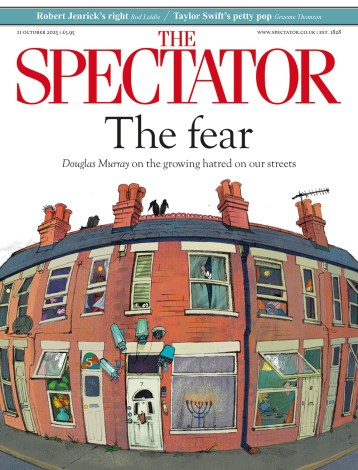I’d always questioned the creative genius of self-confessed ‘living sculptures’ Gilbert and George. Their dogged determination to be seen as ‘different’ felt archly self-conscious and not particularly interesting. Like so many fly-by-night avant-gardists of the 1960s, the duo’s ‘originality’ tended to hang on hoary old controversies such as scatological imagery, sex and nudity – hardly revolutionary even back then.
But listening to the pair’s touching interview with John Wilson on BBC Radio 4’s This Cultural Life recently made me reassess their contribution not just to art, but to the gaiety of the nation. George is now in his early eighties with Gilbert not far behind, and what I found refreshing about these two throwbacks to a more vigorous creative age is how they have remained true to their artistry. The pair’s strange otherworldliness is still rooted in a very real but disturbing reality. Their desire to keep churning out ever more startling imagery suggests my cynicism about them may have been unfair.
Still living inseparable lives in the same handsome east London house they have shared for more than 50 years, the couple’s determination to remain outsiders is tempered by the reality of being deeply connected to a particular place. Even among the noisy distractions of modern-day east London, they have managed to keep life simple – anything that interferes with the higher purpose of creating art is viewed as a distraction.
What I found refreshing about these two throwbacks to a more vigorous creative age is how they have remained true to their artistry
Despite fame and considerable fortune, the two have become cultural landmarks in their little corner of Spitalfields. Gilbert reckons they are the longest-standing inhabitants of the area – they moved to Fournier Street, once home to fleeing Huguenots, in the late 1960s. The couple rarely leave the neighbourhood and continue to eat breakfast at the same café every morning – one slice of marmalade toast each and nothing more, recounts George in his quietly urbane voice that brings to mind a gentler Prince Charles.
Sticklers for routine, their lunch consists of a piccalilli sandwich at Nelly’s café a couple of streets away, with dinner being a slightly more complicated affair involving two buses to their favourite haunt in north London where they dine on ‘vegetables and one chop each’. When food is primarily seen as fuel, having to choose from a menu is just another waste of valuable thinking time.
The same can be said about holidays and clothing. Donning an identical suit and tie each morning may seem like an affectation but is a convenient way to circumvent having to make time-consuming decisions. The smart attire is also an attempt not to alienate the public by seeming too weird, like so many of their contemporaries who ‘wear scruffy beards and sandals’.
Wintering in Malaga used to appeal, but the two are now of the opinion that ‘life is a holiday compared with what is to follow’ and that ‘not much can be achieved lying by a pool with a glass of wine’. And so the focus these days is entirely on creating the sort of relatable art that doesn’t patronise or hide behind impenetrably obtuse pretentions.
The John Wilson interview even convinced me that the couple’s use of excrement is more than just a cheap gimmick. Confronting ‘what we are’ at our most basic is a touching reminder of how far human sanctity remains at odds with the more venal reality of our physical selves. Incorporating it into the spiritual realm of a stained glass window demonstrates that poignancy: why wouldn’t we want to escape the mundanity of daily bowel movements?
With more than 3,000 artworks behind them, that boyish enthusiasm for the work remains undimmed: ‘It’s called the creative process and it’s the most magical thing in the world. Every day we are thrilled to be able to create something.’ Putting in 12-hour days is common even now, with recent works focusing on paradise and the afterlife and on our connection with the earth and with each other.
Asking whether this unlikely couple still get along is what George calls ‘the great heterosexual question’. With so much fighting and unpleasantness in the world the two have made it their mission not to be part of the tumult, by remaining civil both to each other and to the many fans that hang around Fournier Street hoping for a glimpse of their heroes.
Gilbert Prousch and George Passmore represent the last of a dying breed of unselfconsciously arty English eccentric. Playful, engaging and delightfully dotty, they may be in their dotage, but as Gilbert insists: ‘We are not gaga yet.’






Comments